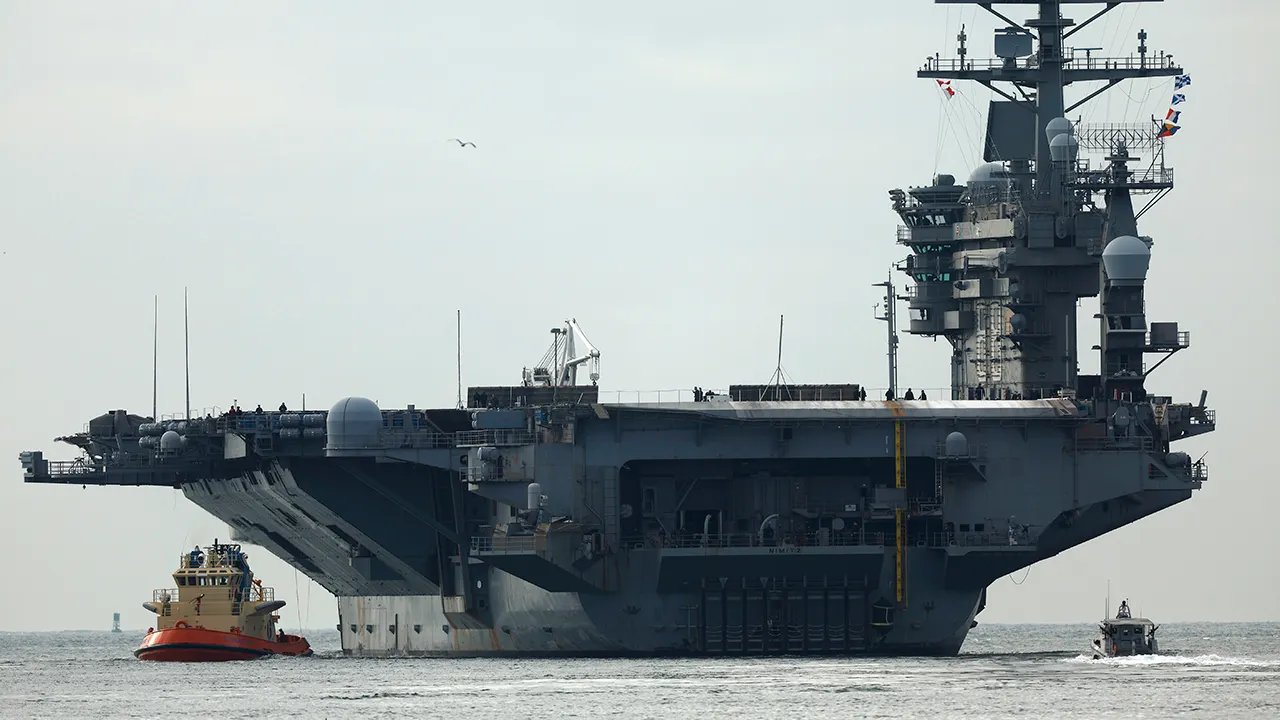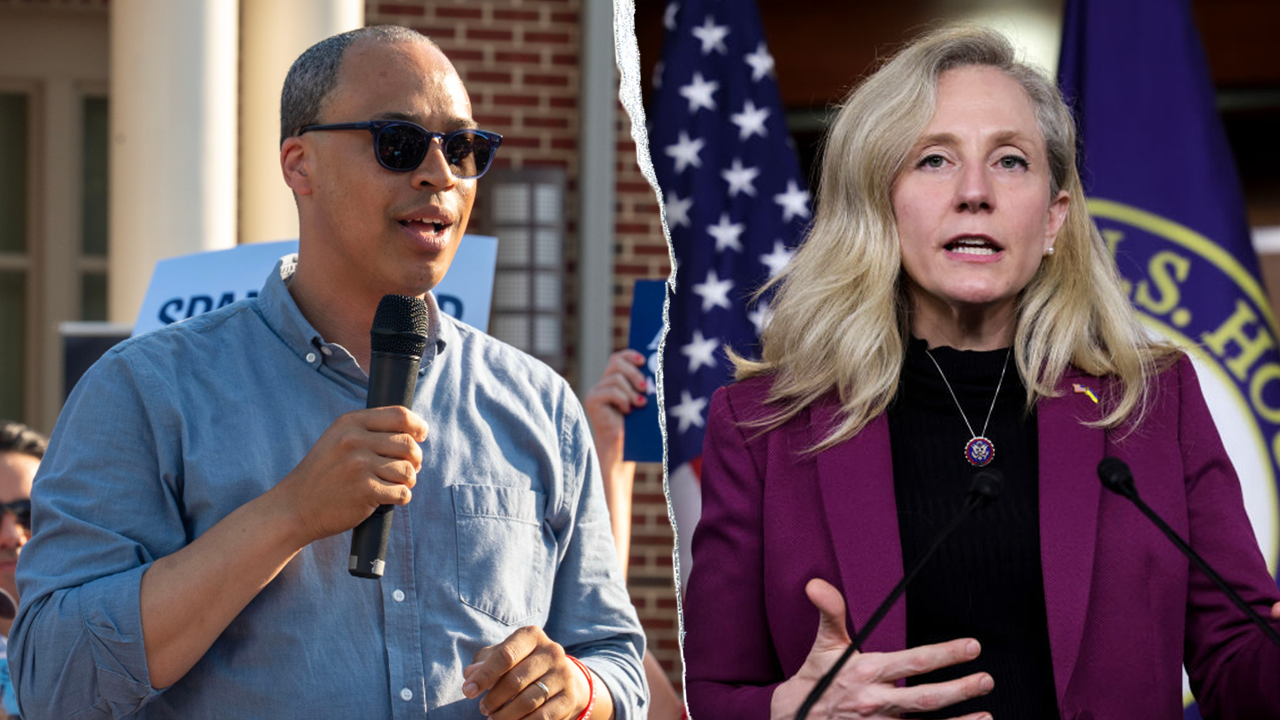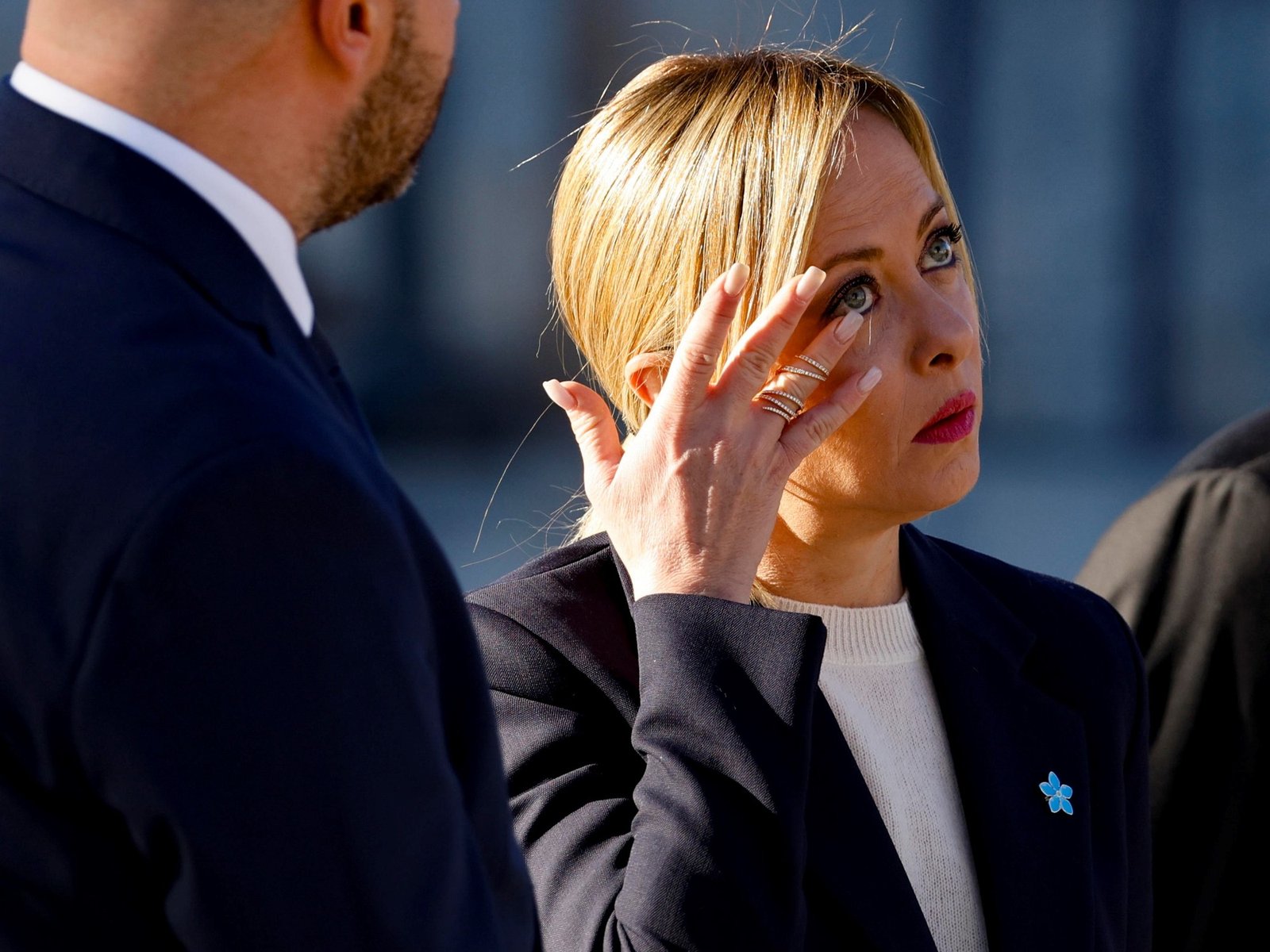INTERNACIONAL
US Navy Sea Hawk helicopter, F/A-18F Super Hornet fighter jet go down in separate South China Sea incidents

NEWYou can now listen to Fox News articles!
Two U.S. Navy aircraft from the USS Nimitz — a Sea Hawk helicopter and an F/A-18 Super Hornet fighter jet — crashed during separate «routine operations» over the South China Sea on Sunday, with all five crew members rescued and in stable condition as the Navy investigates both incidents.
The U.S. Pacific Fleet — the Navy’s largest operational command — said in a post on X that around 2:54 p.m. local time, an MH-60R Sea Hawk helicopter assigned to the «Battle Cats» of Helicopter Maritime Strike Squadron 73 crashed in the South China Sea while conducting routine operations from the aircraft carrier USS Nimitz (CVN 68).
Search-and-rescue teams from Carrier Strike Group 11, operating alongside the Nimitz, quickly launched recovery efforts and safely pulled all three helicopter crew members from the water.
Officials said the personnel were returned to the carrier for medical evaluation and were later confirmed to be in stable condition.
NAVY CALLS OFF SEARCH FOR MISSING SAILOR ASSIGNED TO USS GEORGE WASHINGTON NEAR AUSTRALIA
Roughly 30 minutes after the helicopter incident, an F/A-18F Super Hornet from the Nimitz, assigned to the «Fighting Redcocks» of Strike Fighter Squadron 22, also went down in the South China Sea during flight operations.
Search-and-rescue teams again responded swiftly, recovering the jet’s two crew members, who had successfully ejected before the aircraft hit the water. Both aviators were transported back to the Nimitz and are reported to be in stable condition.
The U.S. Pacific Fleet said in a statement that all five service members involved in the crashes are safe and accounted for.
SECRETARY OF STATE RUBIO CONFIRMS BECOMING ACTING USAID CHIEF
In this handout photo provided by the Navy Visual News Service, the Nimitz-class aircraft carrier USS Dwight D. Eisenhower (CVN 69) gets underway, following a port visit to Naples, Italy October 21, 2006, at sea. (Miguel Angel Contreras/U.S. Navy via Getty Images)
The causes of both incidents remain under investigation, and the Navy has not released additional details about weather conditions, possible mechanical issues, or the nature of the training missions being conducted at the time of the crashes.
While investigators work to determine what led to the two mishaps, operations aboard the USS Nimitz have continued as the carrier remains deployed in the Indo-Pacific region.
‘THIS IS ABOUT FENTANYL’: TARIFFS ARE CRUCIAL TO COMBATING ‘DRUG WAR,’ TRUMP AND CABINET OFFICIALS SAY

An MH-60S Sea Hawk helicopter lands aboard the aircraft carrier USS Nimitz in the South China Sea, Sunday, Feb. 12, 2023, as Nimitz in U.S. 7th Fleet was conducting operations. The 7th Fleet based in Japan said Sunday that the USS Nimitz aircraft carrier strike group and the 13th Marine Expeditionary Unit have been conducting «integrated expeditionary strike force operations» in the South China Sea. (Mass Communication Specialist 2nd Class Justin McTaggart/U.S. Navy via AP)
The Nimitz—the Navy’s oldest active aircraft carrier—is serving as the centerpiece of Carrier Strike Group 11, which routinely conducts freedom-of-navigation and maritime security operations in the South China Sea, waters that have become increasingly contested amid rising tensions between the U.S. and China.
The incidents come as the Nimitz undertakes its final deployment, capping more than 50 years of service since its commissioning in 1975. The carrier was previously involved in Operation Eagle Claw, the failed 1980 mission to rescue American hostages in Tehran.
CLICK HERE TO DOWNLOAD THE FOX NEWS APP
The crashes also coincided with President Donald Trump’s visit to Asia. The president spent Sunday night in Malaysia, located along the southern edge of the South China Sea, and he was expected to depart for Japan on Monday.
navy,us navy,asia,pacific
INTERNACIONAL
Cuando San Martín viajó a Italia y lo declararon muerto

“A comienzos de noviembre viajé a Italia, con la intención de probar si su clima benigno me ayudaba a recuperar la salud, hasta ahora he logrado pocas mejoras”. El que escribe se llama José de San Martín, ha liberado varios países de América y está exiliado, vive en Francia. Es el año 1846 y San Martín le está hablando a Juan Manuel de Rosas, a quien se dirigiría como “Mi apreciado general y amigo”. Su intención de curarse no iba a salir bien.
Esto, y más, aparece en Il viaggio in Italia del generale José de San Martín (El viaje a Italia del general José de San Martín), un libro que escribió Gerardo Severino, un militar italiano ya retirado, que fue “Coronel en Auxilio de la Guardia di Finanza”.
Efectivamente, San Martín había llegado a la Península el 19 de noviembre de 1845, con 67 años y antiguos dolores reumáticos. Desembarcó en Livorno desde un buque (muy probablemente el vapor “Polifemo”, con bandera napolitana) que había partido algunos días antes desde Marsella.

Esto, naturalmente, después de haber hecho colocar en su pasaporte francés el visado correspondiente otorgado por el caballero Antonino Guazessi, entonces cónsul general del Gran Ducado de Toscana en esa misma ciudad portuaria francesa.
El barco de pasajeros había hecho escala en Génova, como era habitual entonces para la mayoría de las compañías de navegación, cuenta Severino.
Algunos días después, el general argentino tomó asiento en una elegante diligencia de la “Strada Ferrata Leopolda”, llegando así entre los primeros pasajeros a la bellísima Florencia, capital del recién formado Gran Ducado de Toscana, cuyo trono ocupaba Leopoldo II.
Según cuenta Severino, en la misma ciudad, es muy probable que se haya reunido con el marqués Hippolyte de La Rochefoucauld, entonces embajador de Francia en ese Estado, así como con otras personalidades que entonces vivían en la extraordinaria escena artística italiana.
Y, dice, “en esa misma Florencia, don José habría podido informarse, conociendo bastante bien nuestra lengua, gracias al muy difundido periódico “Gazzetta di Firenze”, sobre las noticias relacionadas con la crisis que afectaba a la Argentina». No lo iban a dejar tranquilo las noticias. Unos meses antes, en agosto, Inglaterra y Francia habían bloqueado el Río de la Plata. Venían tiempos aún más difíciles.

El viaje no terminaba en Florencia. “El destino de la continuación del viaje fue, entonces, la bellísima Nápoles, capital del Reino de las Dos Sicilias, bajo el reinado de Fernando II de Borbón, pero también un lugar de atracción para muchos viajeros extranjeros, fascinados por sus bellezas naturales y artísticas», dice Severino.
Por eso, por su cultura, “el estadista argentino tenía en mente establecerse allí por algún tiempo, si no de modo permanente, como confirman algunos documentos posteriores”.

San Martín llegó a Nápoles en los primeros días de diciembre de 1845– ¿Planeaba quedarse allí? Severino tiene una pista. Escribe:
“Es precisamente por medio de la “Gazzetta Piemontese” que hemos tenido confirmación de un detalle particular, pasado por alto por muchas fuentes biográficas referidas al estadista argentino. En el preámbulo del artículo periodístico antes citado se lee:
‘En una carta con fecha en Nápoles, el general ha expresado el deseo de permanecer por largo tiempo, y quizás terminar sus días en esa ciudad.’»

Es desde Nápoles, justamente, que le escribe a Rosas. No quiere contarle sus dolores, aunque lo haga. Lo que quiere es decirle que, debido a ellos, no puede ofrecerle sus servicios ante el bloqueo anglo-francés. San Martín quiere manifestarle a Rosas “mi confianza no dudosa del triunfo de la justicia que nos asiste”. Lo hace desde Nápoles. Se iría días después “no sin antes haber obtenido el visado del cónsul del Estado Pontificio en la ciudad, el caballero Domenico Albertazzi“. dice Severino. El autor arriesga que lo había molestado demasiado el bullicio de esa ciudad del sur de Italia.
San Martín se fue de Nápoles a Roma en diligencia. “Aquel día también partieron hacia la capital pontificia el barón Adolfo Rothschild, Giuseppe Mazzini di Varzo, Antonio Dondi Orologio (de Padua), los hermanos Gaetano y Francesco Calderari, músicos, el pintor Gennaro Ruo, y un tal Giuseppe per San Martino dell’America del Sud domiciliado en Francia, propietario, junto al caballero Giacomo de Prandi de Ulmhart, austríaco y vicecónsul de Noruega residente», dice Severino.
El viaje duró treinta horas. “Atravesó las localidades de Capua, Gaeta, Formia, Terracina y Velletri, en un recorrido de alrededor de 194 kilómetros”.

No lo esperaba lo mejor. Según Severino «José de San Martín no era precisamente un huésped bien visto en Roma, sobre todo tras su conocido apoyo a Juan Manuel de Rosas». Lo que pasaba era que “gran parte de los Estados italianos, en efecto, se habían ‘alineado’ con Francia e Inglaterra, antes que con la Confederación Argentina».
Los diarios hablaban de Rosas como un dictador. Y, mientras tanto, cerca de las tierras de San Martín, Garibaldi llevaba su “Legión Italiana”, compuesta por 200 hombres, a la batalla de San Antonio del Salto, en Uruguay. Combatieron contra los aliados de Rosas.
En Roma, San Martín seguía de cerca los acontecimientos de su patria. Estaba preocupado. Y las cosas se pondrían peor. Escribe Severino:
“Una noche de febrero de 1846 (unos pocos días antes de la partida definitiva del general desde Roma), al regresar al mismo hotel, Gervasio de Posadas, quien había vuelto de Nápoles a la capital italiana, fue sorprendido por el doméstico de San Martín, quien le comunicó literalmente que El Libertador había muerto.
En realidad, fue el propio Gervasio de Posadas quien descubrió que don José estaba aún con vida, víctima de un ataque epiléptico o convulsivo (según se cree), del que, por fortuna, logró recuperarse tras algunos días de reposo».
Severino especula que fueron las noticias que llegaban desde Buenos Aires lo que descompensó al General. Pero San Martín mejoró. Volvió a Francia. A Boulogne Sur Mer. El resto es historia conocida.
ministerio de cultura de la nac,museo histórico nacional,sable corvo,sable corvo de san martín,san martín
INTERNACIONAL
Inside Jay Jones and the Democrats’ late surge to upset wins across Virginia, from the suburbs to the shore

NEWYou can now listen to Fox News articles!
Virginia took on new life Tuesday as a Democratic stronghold, with Abigail Spanberger, Jay Jones, and Ghazala Hashmi sweeping the statewide races — marking the party’s largest power shift in more than a decade as Republicans lost at least a dozen legislative seats.
BEACH VIBES
The Virginia Beach and Greater Hampton Roads area appeared to be the biggest boon for hometown son Jones, who represented Norfolk in the state legislature and whose namesake father did for years prior.
Several Tidewater counties that backed Glenn Youngkin in 2021 flipped blue this time, helping boost Jones and the Democratic ticket.
The densely populated independent cities of Virginia Beach, Chesapeake joined typically Democratic Suffolk, Norfolk and Newport News to help propel Jones to victory, according to postmortem maps.
Virginia Democratic gubernatorial Abigail Spanberger was excoriated online for refusing to withdraw her endorsement of fellow-candidate Jay Jones. (Maxine Wallace/The Washington Post/Getty Images; Getty Images)
James City County – which surrounds Williamsburg – and Surry County, an otherwise right-leaning area across the river from Jamestown – also landed in Jones’ lap on Election Night.
New Kent County — where Jones was previously cited for driving 116 mph — remained in outgoing Attorney General Jason Miyares’ favor.
But, across the Chesapeake Bay Bridge-Tunnel on the Eastern Shore, rural Northampton County also went for Jones — while its adjacent counterpart Accomack stayed in Miyares’ hands.
The overall trend in that region depicted Jones’ neighbors as a big part of his victory Tuesday.
D.C.’S BLUE FOOTPRINT EXPANDS
Meanwhile, in Democratic-friendly northern Virginia, turnout margins for Republicans appeared anemic compared to 2021, when Youngkin and Miyares won their upsets.
Ticket-splitting in the Washington exurbs appeared to help Jones as well as the increasing population density fed by federal workers and others creating ever-distant bedroom communities of Washington, D.C.
As Washington, D.C.’s population expands south and west, nearby counties like Stafford and Spotsylvania — as well as Loudoun, Fauquier and Clarke — have trended sharply toward Democrats.
ABIGAIL SPANBERGER SEALS HISTORIC VIRGINIA WIN, ENDING GOP’S GLENN YOUNGKIN ERA
Spotsylvania County went for Spanberger but eschewed Jones in favor of Miyares. To the north, Stafford County – once more rural but now overtaken by subdivisions and enlarged I-95 interchanges to deal with the population increase – was lost to Democrats up and down the ballot after Youngkin won it in 2021.
In Stafford, Republican Del. Paul Milde lost his seat to Democratic Del-elect. Stacey Carroll, who had successfully weathered a residency dispute during her tough race that was eventually ruled in her favor.
In Loudoun, Prince William and Fauquier counties west of Washington, Democrats unseated otherwise popular incumbent Republicans Geary Higgins and Ian Lovejoy – foreshadowing Spanberger and Jones victories in all.
VIRGINIA SPECIAL ELECTION IN DEEP-BLUE DC SUBURBS CAN STILL GIVE INSIGHT INTO KEY GOVERNOR’S RACE
The reverberations from the election were also felt across the mountain in West Virginia’s eastern panhandle, where by Wednesday morning, social media was buzzing with commentary and memes similar to how Floridians have been addressing New Yorkers — suggesting Virginians either stay where they are and deal with their newfound leftward bent, or not to bring their politics if they move into Jefferson and Berkeley counties.
The two states originally split in 1863 over political differences as well, after a convention of Virginia delegates upset over Richmond’s plans to secede from the Union met in Wheeling to ultimately agree to the «Restored Government of Virginia» – which became West Virginia.
Jefferson County, the farthest-east confine of West Virginia; neighboring Loudoun, has become the second-most Democratic county in the all-Republican state besides Monongalia – which houses West Virginia University – as the blue footprint from Washington expands even beyond what was seen Tuesday.
The margin increases Youngkin saw in Loudoun and vicinity in 2021 were muted Tuesday, helping Spanberger, Jones and Hashmi all claim victory.
The same was evident for increasingly populated counties around Richmond, as Chesterfield – Hashmi’s home county – flipped blue and Henrico saw increased margins for hometown favorite Spanberger.
SOUTHWEST STAYS RED, BUT FEWER TURN OUT
Elsewhere, the more rural, otherwise Republican-friendly New River Valley swung leftward as well on Tuesday – with Montgomery County landing in Democratic hands according to postmortem percentages in multiple outlets.
Del. Chris Obenshain, part of a prominent Virginia Republican political family, was unseated as part of the blue wave — and Spanberger and Jones took the Youngkin-won county that features Virginia Tech and Christiansburg.
In 2021, Youngkin «ran up the score,» as pundits said, in deep-red southwestern Virginia.
NEW POLL IN KEY SHOWDOWN FOR VIRGINIA GOVERNOR INDICATES SINGLE-DIGIT RACE
This year, Republicans still held their state legislative seats there, and voted for Miyares and Winsome Earle-Sears – but the contests were closer and with smaller numbers.
In far-flung Lee County – longitudinally west of Detroit and closer to Mississippi than Washington, D.C. – 1,000 fewer Republicans turned out for Earle-Sears than Youngkin.
That trend continued up the mountainous, diagonal border with Kentucky – as Wise, Dickenson, Buchanan, Tazewell, Bland and Giles counties all turned out in much lesser numbers for the regionally-favored GOP candidates.
CROOKED ROAD; BRIGHT SPOT
One small bright spot remained on the map for Republicans as of Wednesday.
The area comprising Virginia’s famous «Crooked Road» – considered the birthplace of country music and bluegrass along today’s U.S. 58 in the Appalachian hills – provided similar figures for Earle-Sears and Miyares as it did for Youngkin and Miyares four years ago.
Just as NASCAR fans packed Martinsville days earlier, Republicans in the surrounding counties showed up in only slightly smaller numbers than four years ago.
LOOKING AHEAD
A Republican official told Fox News Digital after the results came in Tuesday that Virginia politics can often be a «rubber band» that stretches one way and releases another as time passes.
Ever since the «Byrd Machine’s» 70-year Democrat grip on Virginia politics that subsided in the late 20th Century after the passing of ex-Gov. Harry Byrd, there has been an ebb-and-flow of partisan power in Richmond often contingent on who is in the White House.
Youngkin’s 2021 victory was seen by political observers as an indictment of the Biden administration, as much as Spanberger’s and Jones’ was to that of President Donald Trump.
FOX NEWS POLL: HOW SPANBERGER WON VIRGINIA GOVERNOR
Prior, Gov. Ralph Northam won in the second year of Trump’s first term, and so forth.
But Virginia had not seen such a drastic tidal shift until Tuesday.
CLICK HERE TO DOWNLOAD THE FOX NEWS APP
Sen. Mark Warner, D-Va., is up for reelection in 2026, and already one conservative – state Sen. Bryce Reeves, R-Orange – has announced his run against the entrenched incumbent.
In her concession speech, Earle-Sears said she’s «not going anywhere» – but it remains to be seen if she, Youngkin or another Republican may make Reeves some company and try to use Warner’s race as the same type of response to any shortcomings of the Spanberger-Jones era.
virginia governor race,washington dc,virginia,republicans elections,southeast,abigail spanberger
INTERNACIONAL
La agónica caída de Italia: deuda, población en baja y la amenaza de China

El fantasma de China
Datos que producen escalofríos
Menos población

 POLITICA2 días ago
POLITICA2 días agoKicillof quiere declarar en emergencia económica a la provincia y pide autorización para tomar más deuda

 DEPORTE3 días ago
DEPORTE3 días agoDirecto a los libros de historia: el tremendo récord de victorias del Bayern Munich

 POLITICA3 días ago
POLITICA3 días ago“Haré lo que tenga que hacer para lograr las reformas”: el primer mensaje de Santilli tras ser designado ministro del Interior




























